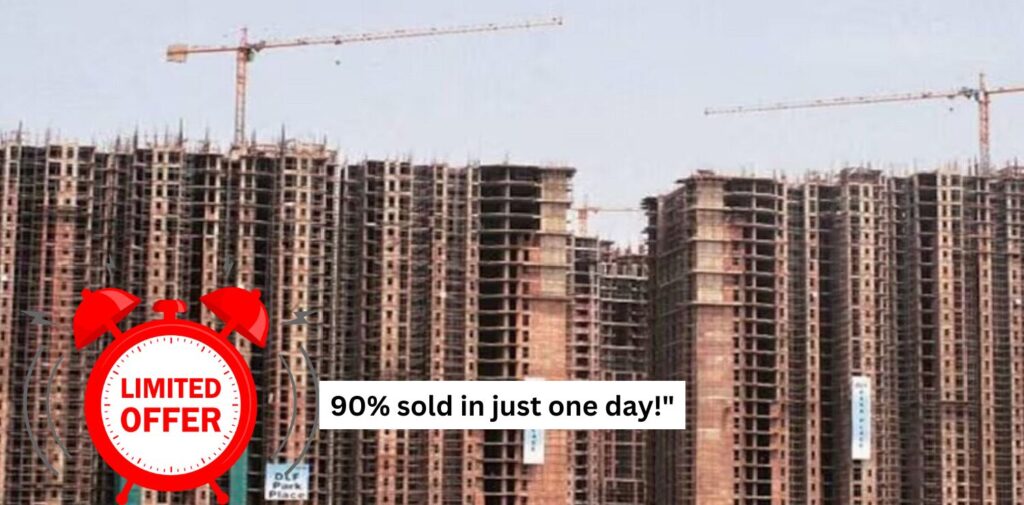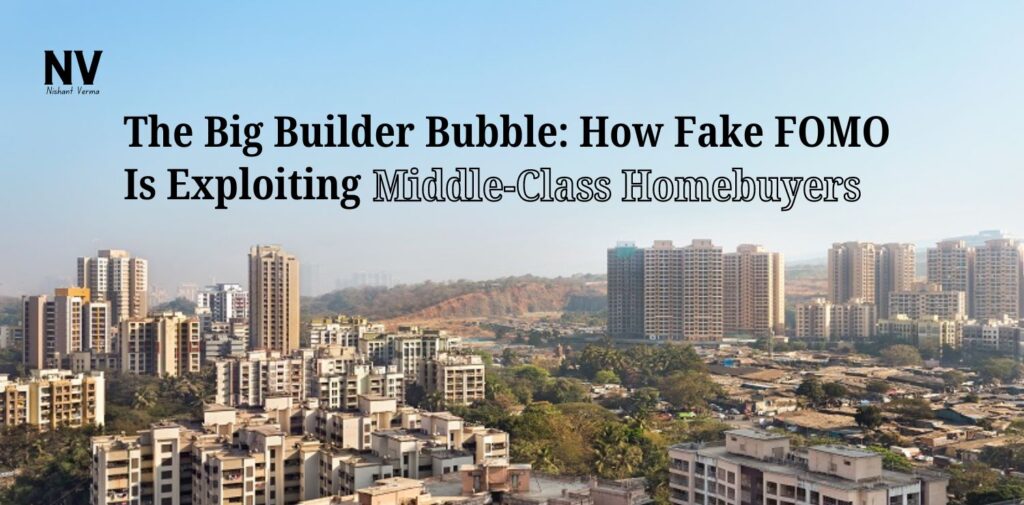In recent years, India’s real estate industry has witnessed a disturbing trend. Large builders and developers have been using manipulative tactics to create a false sense of urgency, also known as FOMO (Fear of Missing Out), to lure middle-class families into purchasing homes. These so-called “sold-out” projects, advertised as being snapped up within hours or days, often turn out to be part of a well-orchestrated game played by builders to inflate prices and create an artificial demand bubble.
The reality is, that much of the stock is held by private investors or insiders, leaving the common homebuyer scrambling to purchase at inflated prices. This article aims to expose the deceptive practices of these builders and how they are harming the very people they claim to serve: middle-class families looking for a home.
The Illusion of Scarcity: How Fake FOMO Is Created
The foundation of this scam lies in creating an illusion that a project is in high demand and will sell out quickly. As soon as a project is launched, big developers flood the market with advertisements that scream, “90% sold in just one day!” or “Limited units left, book now!” They create a frenzy, making buyers believe that if they don’t act immediately, they’ll miss out on a once-in-a-lifetime opportunity. This psychological manipulation pushes potential buyers to rush their decision without doing thorough research, all because they fear they might be left behind.
However, behind the scenes, a different story is unfolding. Many of these “sold-out” properties are being held by private investors or the builder’s inner circle. These units aren’t available to the public at all. Instead, they’re reserved to be sold later at a much higher price, once the artificial demand has inflated the property’s value. This leaves genuine buyers with fewer options, forcing them to buy at inflated prices, or worse, from the secondary market where prices have skyrocketed even further.

Private Investors: The Puppeteers Behind the Curtain
The real beneficiaries of this game are private investors—often wealthy individuals or groups who have prior arrangements with the builders. They scoop up large chunks of units before the project is even officially launched. This isn’t an investment for them; it’s a calculated move to hoard properties and sell them at a profit once the market price rises, which the builders themselves help orchestrate by continuing to push the narrative that the project is selling out fast.
This cozy arrangement between builders and investors creates a massive imbalance in the real estate market. Projects that are supposedly “sold out” aren’t going to end users but to speculators. By controlling the initial supply, both the builders and investors can dictate the price, leaving genuine buyers with no choice but to pay a premium. For a middle-class family, this means spending lakhs more on a home than they should have, simply because the market has been rigged in favor of the few.
The Impact on Middle-Class Families: A Housing Dream Turned Nightmare
For most middle-class families, buying a home is the single biggest investment they will ever make. It’s a dream nurtured over years of hard work and savings. However, thanks to the manipulative practices of these big builders, that dream is being turned into a financial nightmare.
The artificially inflated prices make it nearly impossible for a middle-class family to buy a home within their budget. Even if they manage to secure a loan and make the purchase, they often end up paying exorbitant EMIs for years, stretching their finances thin. This not only impacts their present lifestyle but also jeopardizes their future financial security. A home, which should have been a source of stability and pride, becomes a burden, thanks to the greed of builders and investors who manipulate the market for their gain.
Moreover, the rush to buy due to FOMO leads many families to make hasty decisions. They might compromise on the quality of the property, the location, or the amenities, simply because they believe they have no other choice. Later, they may discover that the property doesn’t live up to the promises made during the launch. By then, it’s too late—they’re locked into a mortgage, and their dream home becomes a source of regret.

Creating a Bubble: The Dangerous Consequences
The manipulative practices of big builders are not just unethical—they’re dangerous. By creating a false sense of scarcity and driving up prices, they are effectively creating a real estate bubble. As more and more people buy into these inflated prices, the bubble grows larger. But like any bubble, it’s only a matter of time before it bursts.
When this happens, the consequences will be devastating, especially for middle-class families who have invested their life savings into these homes. As property values plummet, they will be left with homes that are worth far less than what they paid. Many could find themselves in negative equity, where the outstanding mortgage is higher than the market value of the property. This will not only their financial stability but also their confidence in the real estate market as a whole.

Regulation and Transparency: The Need of the Hour
So, what can be done to protect homebuyers from these predatory practices? The answer lies in stricter regulation and increased transparency in the real estate sector.
First and foremost, developers must be required to disclose how many units have actually been sold to end-users, not private investors. This will give buyers a clearer picture of the real demand for the project. Additionally, real estate regulators should closely monitor pricing practices and impose penalties on developers found to be artificially inflating prices through such manipulative tactics.
There is also a need for better consumer education. Homebuyers should be encouraged to take their time, do their research, and not fall for marketing gimmicks designed to create FOMO. They should understand that a project being “sold out” doesn’t necessarily mean it’s a good investment—it might just be a part of a larger game being played by builders and investors.
Conclusion: A Call to Slam the Big Builders’ Manipulative Tactics
The manipulative practices of big builders are creating an unfair, unbalanced real estate market that is exploiting middle-class families. By creating a false sense of scarcity and using FOMO to drive up prices, they are making it increasingly difficult for genuine buyers to afford a home. Meanwhile, private investors and insiders are reaping the rewards, further widening the gap between the rich and the rest.
It’s time to call out these practices for what they are: unethical and harmful. Middle-class families deserve better, they deserve a fair, transparent, and affordable real estate market where they can buy a home without being taken advantage of. Until builders are held accountable for their actions, the dream of owning a home will continue to slip further out of reach for many.
The big builders’ bubble must burst before it causes even more damage to India’s hardworking families.




